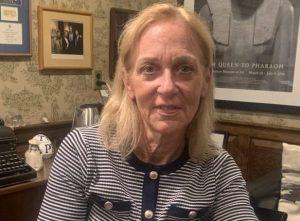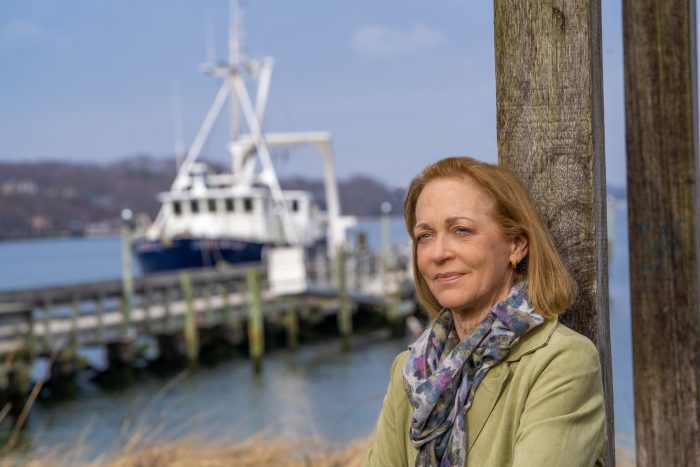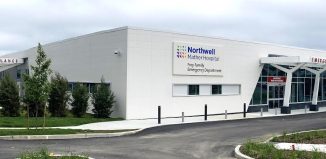Port Jefferson Mayor Lauren Sheprow speaks on first term, shares aspirations for village future
TBR News Media invited Kathianne Snaden, Lauren Sheprow’s opponent for the mayoral race, to participate in the interview as well, but she declined. Coverage of her position, as well as the three candidates competing for two trustee positions, can be found in the article, “Tense atmosphere dominates meet-the-candidates night”.
What surprised you about the position during these last two years?

Everything. I knew a lot about governance from working with Stony Brook’s faculty and staff and administration for sixteen years, both in the hospital and on the main campus. So, that gave me some bearing. I think what surprised me really was the level of vitriol that continued for two years. It never stopped and that was sad. I thought the opposition would sort of weigh in, get involved and help out with their community, but I didn’t get that reaction, so I don’t focus on it. It isn’t something that I think about. But to say what surprised me, that surprised me. The number of hours it takes to do this job surprised me. But, and I’m not gonna say it surprised me, but I did not have an understanding of the extent of the complexities that exist in this small three square mile piece of land.
What are your financial plans for the village?
I established early on a budget finance committee through code. It was legislated. There was never a budget and finance committee in the code. So now it’s chapter seven in the code, and it is a seven member board committee. It’s a committee–it’s advisory by nature. And so, I also have a very gifted and intelligent trustee who is our finance commissioner. I don’t know if ever in the history of Port Jefferson there has been a finance commissioner who’s been a trustee, but this is a person that I know knows more about finance and budgets than I do. So my goal is to keep the budget balanced, obviously. My focus is to keep the taxpayer levy as even as possible without raising taxes to a great extent. And to be able to do that, we are really focusing on grants and grant administration, which is a whole job in and of itself. We’ve been very successful with our new grant administrator, Lisa Mato. And, she’s been very successful in getting grant money reimbursed to the village that has been long standing. So, financial goals: get the capital fund back to where it has been, get it back to balanced, and then start building a capital reserve so that if we have big expenditures that we need to make, we have the funding to do it.
How are you planning to move forward in mitigating flooding?
Oh, great question. I’m very excited about this. The former administration got a FEMA grant for flood reduction studies. We got the grant. The thing you have to do when you get a grant is you have to get an executed contract so that you get reimbursed. If you do have to put your own money out, which we do, we wanna make sure we have an executed contract. It takes a long time. It can take up to eighteen months to get that executed contract back. So we got the executed contract back for that grant. We did an RFP. We hired an engineering firm who we contracted with and we had our kickoff meeting last week with L.K. McLean Associates. So the goal of this flood reduction study is to come up with a plan on how to mitigate flooding in the downtown area. But the scope of the work, they did it. They’re doing a topographical study with the drone footage that extends from the Northeast corner of Harborfront Park, which is where it meets the yacht club, all the way southwest to Brook Road where it meets Old Post Road, and all points in between, including the school district property, the fire district property, the apartments on Main Street, and all that road. They’re mapping our stormwater, sewers, and stormwater catch basins. Anyway, I could go on forever about this, but I’m very excited. We’re meeting with the school district and the fire district on Wednesday to introduce them because they are major stakeholders in this study.
What is the most pressing issue facing the village right now?
I would say it’s the hazard issues related to climate. Flooding is the most pressing issue. And also the impact to the East Beach Bluff and our old Homestead Recharge Basin. That August storm caused so much damage. We’re getting funding to mitigate the damage. We’re cleaning out storm drains, about up to 50 storm drains. The cost will be reimbursed by FEMA. It could be up to $100,000 to clean out 50 store drains. We’re asking the residents to help us pick the right ones that are most problematic. After that storm, we fixed every single roof in the village. Every single roof was leaking in the village, and we fixed all the village-owned roofs. We didn’t get refunded for all of that work, but for some of that. Fixing our maintenance issues is the most important thing for the village that the village government can do for its residents right now.
What are your thoughts on the Port Jeff Country Club?
So if you talk to real estate agents, the three things they use to sell Port Jefferson are the country club, the beaches and the school district. Those are the three most important things, and it has an impact on the value of the homes, on the quality of life, and on the future of how people spend their days in the village
I think the country club is a major asset. It was purchased for $2,300,000. It’s probably worth, you know, $100,000,000 right now or $75,000,000. But it makes a lot of people very, very, very happy. Right now, we have our work cut out for us because we have a blank slate on the north side of Fairway Drive. We’re bringing in a master planner to give us an impression of what they think can happen on that north side and and throughout the whole to give us an assessment of the country club. This is an experienced country club master planner and at no cost, except for maybe travel expenses, they’re coming in. They’re going to present to us what their impressions are. So that’s going to give us a way to shape our thinking about what’s possible there and what we should do. In terms of the bluff and the and the building, that building is being utilized to its full extent by Lessing’s Hospitality Group.
That restaurant is closed now, right?
We’re working with Lessings to get that restaurant open a few days a week. That could service the community as well as the members.
They’re not operating an á la carte restaurant business. So both vendors who were here prior did not make that restaurant work. Their focus was really on different things. I don’t wanna talk for them, but then Lessing’s came in. They were honest; they said, we’re not gonna be able to provide an a la carte restaurant’s business right away; we have to get our feet under us. We have to get this business up and running.
The contract with Lessing’s is a 9% profit share. So they make money, the village makes money.. And the other reason why the country club is an asset to this village is because the partner who pays the rent in that building offsets the tax levy by 2%. So as their revenue grows, the village revenue grows.
I mean, they’re putting on activities every single week, quite a few. Once they hit their stride and they’re really cooking and we see our revenue numbers going up, I’d like to use that revenue and put it right back into the cost of what it costs to fix that bluff so that it offsets tax payer. We anticipate that the numbers will grow. And, after talking to our treasurer about this, this is maybe two or three years down the road, but eventually, I’d like to pay that debt off that we had to take to pay for the project through the income that we make–the revenue that we draw from Lessing’s. That’s the draw.
And they are changing the aesthetic of the place. No offense to anyone’s decorative eye, but they’re bringing back a coastal feel on the inside of that facility. They’re removing and eliminating as much marble on the flooring and everything, and they’re bringing in a wood floor from the moment you step out to the deck area. So it’s in progress. They’re still addressing the things, the aesthetic. They’re addressing the kitchen. They’re putting in a new kitchen, they’re really investing in the business, which says to me, they wanna make it work.
I’ve spoken with David Lessing, and he has said, I think we can make the restaurant work. We just need time.
Why do you feel the East Beach Bluff stabilization project is the right move, and how do you reconcile that with the residents who feel that the project and the country club are a waste of village money?
I took an oath of office which said that my job is to protect and preserve village property. Stabilization of that property is important because it impacts the areas not only where the country club exists, but the areas to the west and to the east of it as well. So if we get FEMA funding to offset 75% of the cost of phase two, whatever phase two ends up being as our engineers are drawing up a valued engineering project plan for phase two, it’s not gonna look like the original phase two and we’re looking forward to seeing what that looks like. If we have up to $3.5 million dollars to offset the cost and offset the taxpayer’s responsibility, to help stabilize that property, it’s a valued property. It is one of the most valuable pieces of property in Port Jefferson and Lessing’s knows it. If they thought it was not valuable, they wouldn’t have rushed in and said, we want this. We wanna make this work. This is a property we have wanted for twenty five years. They wanted this catering facility and this whole building operation when Lombardi’s came in. They had hoped to to be considered for it. So they came to us, and they said, we’re interested in this.
There are a lot of variables to the planning process right now. We’re looking at drainage, which wasn’t looked at in the first place. There’s stormwater coming off the building. We need to redirect that stormwater. We need to capture that stormwater and push it elsewhere. They they did that on the East Side. We’re looking at the drainage now, and our engineers are figuring out a drainage plan. If we need to come up with a pump system to bring it back to the golf course and use it as an irrigation resource, perfect. Use it for irrigation. Or, we can use it when we’re at drought levels, which we’ve experienced before. We’re looking to be sustainable and not just a Band-Aid on a heart attack.
They did look at the utilities or consider or factor them into their planning, the underground utility, infrastructure, and they didn’t look at the stability of the building. So, we’re looking at the stability of the building.
One of the things that I did was establish a Citizen’s Commission on Erosion. I invited as many volunteers who wanted to sit at a round table and talk about the issues that we’re facing and discuss and try to make decisions about along the way. That’s how we got resident input. This erosion commission is no joke. They are looking at everything, and they are asking the right questions, which give us cause to ask the right questions of the engineers.
We hired an engineering firm, which we didn’t have before, to review the engineering designs, question the engineers of record and to also look at other options and how we can do this better. So we hired Hayduk Engineering. Stephen Hayduck Jr. as our principal engineer, and Peter Scully is our environmental consultant. So we’re looking at it in a very disciplined way. We’re not just saying, oh, that plan looks good; let’s go with it. We are evaluating it very, very carefully with input from the community.
The other thing we’re doing, just to add on to that, is we’ve asked our public works department to be the eyes and ears of the monitoring so that we don’t have to have engineers come out. If there’s a heavy storm, the DPW goes out, records, takes photos of what happened and what they’re seeing on the bluff face. So we’re using our own employees who are very capable. It’s not technical. They’re just taking pictures, and they’re recording what the difference might be if they still see something here or there.
Is there an area for improvement within village hall operations?
We’ve done a lot of work on, on reporting structure and organizational charts and where people sit and everything. And there’s always room for improvement for that. We have a limited budget, so we have limited resources of who we can hire and how we do so. We have to make sure we use our resources wisely and so that people are working together. One of the things that I brought back was a department head meeting. So every two weeks, we have department head meetings where our department heads speak to one another, including our public works, park public works, country club. So we are really working together in those terms.
These department head meetings help us understand where our treasurer comes in. He’s sitting right there. If they need to buy something or need to invest in something, they have that conversation in real time. We have these work session reports that we ask every department head to create, and we post those online during our work session meeting as part of the agenda. And it’s open and free for everybody to read. Every single department has a work session report so residents can see how their money is being spent.







